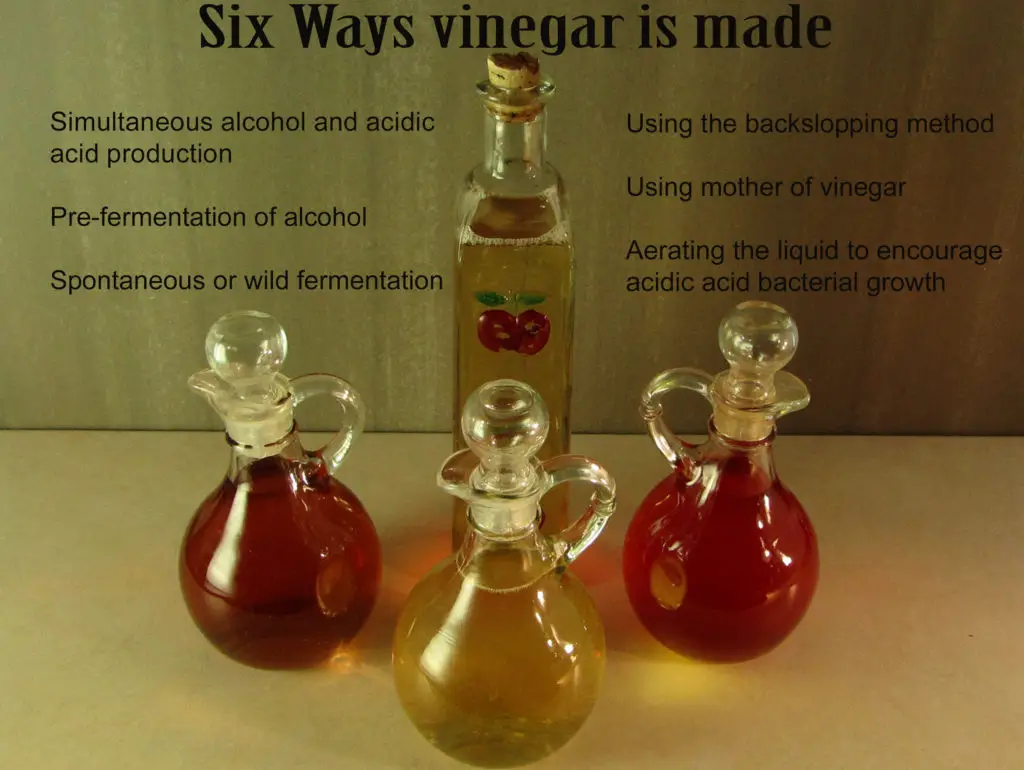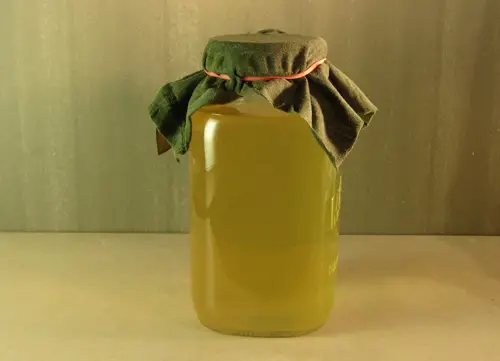This post contains affiliate links.
All vinegar is made by fermentation in a two-step process.
1. Yeast and lactic acid bacteria produce alcohol and lactic acid
The yeast cultures use the sugars in the liquid for growth. The concentration of the alcohol which the yeast cultures make depends on the amount of available sugar in the liquid. The eventual acidity of the vinegar depends on how much alcohol which the yeasts produce.
2. Acetic acid bacteria use the alcohol and lactic acid to make acetic acid
The acetic acid bacteria need alcohol and/or lactic acid plus oxygen to produce acetic acid (which is the acid which gives vinegar its tangy flavor). Acedic acid bacteria will continue to acidify the liquid until either the alcohol in the liquid is exhausted or it reaches a PH of 3.0 at which point the acetic acid bacteria can no longer survive and the acidification of the vinegar stops.
Ways vinegar is made

Although the process of making vinegar requires production of alcohol and exposure to oxygen there are many variations of how this is done.
- Simultaneous alcohol and acetic acid production
- Pre-fermentation of alcohol
- Spontaneous or wild fermentation
- Using the backslopping method
- Using mother of vinegar
- Aerating the liquid to encourage acidic acid bacterial growth
These methods can be combined to produce a wide variety of techniques which accomplish different flavors, acidic acid concentrations and commercial purposes.
Simultaneous fermentation of alcohol and acetic acid
This is the usual method used to make homemade vinegar like this strawberry vinegar. The process is done in a wide mouthed container giving the acetic acid as much surface area as possible. This method can be done with wild yeasts or using some pre-inoculation step (backslopping or addition of mother of vinegar).
simultainious fermentation produces some very interesting vinegars because the alcohol levels of the liquid remains low throughout the process giving yeast cultures which have a low tolerance to alcohol a chance to remain viable. This adds additional flavors to the vinegar that would not be as prevalent if the alcohol was produced first.
Pre-fermentation of the alcohol
Acetic acid bacteria(AAB) need an anaerobic environment to grow. Beer and wine makers take advantage of this by fermenting their beverages in air locked containers which prevent oxygen exchange. This prevents the growth of AAB and encourages the growth of yeast cultures which produce a high alcohol content. To make vinegar out of these types of liquids all that is required is that they get exposed to oxygen. Since AAB are always present in the environment they quickly begin to multiply turning the alcohol into acidic acid (vinegar).
Vinegar can be made by pre-fermenting your vinegar base until the alcohol content has reached 9-12% and then exposing it to oxygen. The vinegar base can be any sweet liquid fermented with alcohol producing yeast. You can use fruit juice, molasses, rice wine or tree sap syrup. The wild fermentation method or some form of inoculation step can be used to convert it into vinegar.
Wild Fermentation method
This method relies on the fact that there are Acetic acid bacterial species in the environment everywhere in the world. This species of bacteria produce acetic acid from alcohol and lactic acid. The liquid can be turned into vinegar using the wild fermentation method by pouring it into a wide mouthed jar and placing a cloth or some other breathable material secured over the top of the jar. The resident acetic acid bacteria will begin to multiply and produce acetic acid and CO2. In a few weeks the vinegar will be noticeably tangier.
Using some type of inoculation
There are two methods of inoculation used in making vinegar
Backslopping
The backslopping method which requires the addition of non-pasteurized vinegar into the liquid. It is not necessary to include the mother which is the solids usually found in the bottom of a container of non-pasteurized vinegars like apple cider vinegar. When backslopping with vinegar it is only necessary to transfer a sample of the acidic acid bacteria which is present in one vinegar into another. This shortens the time the AAB need to dominate the fermentation and acidify it into vinegar.
When using the backslopping method on non-alcoholic sweet liquids it is important to add enough vinegar to acidify the liquid enough to prevent spoilage bacterial growth. To ensure consistent results add 1 part finished vinegar to 4 parts sweet liquid.
Using a vinegar SKOBY
A vinegar SKOBY is like using a kombucha SKOBY. It can be done in two ways.
The continuous vinegar method
This method can produce vinegar on a continuous basis. It is just like continuous kombucha where you start with a sugary or alcoholic liquid and leave it exposed to the air for two to three weeks until it becomes acidified. Soon the wild bacteria in the liquid will begin to form a solid cellulose layer on the surface. Once this happens start tasting the vinegar. When it reaches the appropriate acidity pour some out into a bottle. Top up the jar with more new liquid of the same type.
The batch method
This method is used to make large batches of vinegar which can then be used immediately or aged to develop deeper more complex flavors. In a large glass container place the base liquid you want to use for the vinegar. Add the SKOBY to the jar. Cover the jar to prevent insects from getting to the vinegar and wait. As the AAB increase in population the liquid will acidify.
Aerating the vinegar
There are three methods which are employed to aerate the liquid
The Boerhaave Process
This method can produce vinegar quickly by adding surface area for the acetic acid bacteria to grow on.
To use this method two containers are needed with some type of twigs or other porous material in each container. One of the containers is filled with an alcoholic liquid and the other only a ¼ full. The method is then to transfer from the full container into the empty one until it is full. By doing this daily the surface area is increased when the twigs are exposed to the air and when the liquid is poured from one container to the other. The acetic acid bacteria will grow on the porous material and the transferring from one container to the other will aerate the liquid adding more oxygen for the AAB.
The generator method
This method is similar to the Boerhaave method as its process increases the amount of surface area which the acetic acid bacteria grow on.
The system has two containers one on top of the other. The top container is filled with a porous material. This increases the surface area which the AAB have to grow on which increases their numbers. The bottom container has a pump which pumps the liquid in the bottom container through the porous material in the top container. The liquid flows down through the porous material and drains back into the bottom container.
The submerged method
This is the method most used in industrial vinegar production as it is fast and produces consistent results. The system requires an alcohol solution to be used rather than a sweet liquid.
The container has an air pump located in the bottom which distributes air throughout the liquid providing ample oxygen for the AAB to grow. The process takes only a few days for the alcohol to be converted into vinegar which is why this method is so popular with industrial vinegar makers.
Other Processes which are used in vinegar making
All vinegar is fermented with one of the above methods but once the AAB have done their job there are other processes which some vinegar goes through before it is used.
Distillation
When you buy white vinegar from the store it has been distilled. This is the process of removing any solids, bacteria, yeast and flavors which may have come from the original liquid.
The distillation process is the same as the one used for distilling alcohol but instead of concentrating the alcohol it concentrates the acidic acid.
Aging
Vinegar is like wine, the flavors and feel of the vinegar changes over time. Some types of vinegar are aged over long period of time such as balsamic vinegar or rice vinegar.
Balsamic vinegar is fermented for a period of five to 25 years and undergoes a specific fermentation process. It is aged in casks of various types of wood and is transferred into smaller and smaller casks as the vinegar is concentrated and takes on the various flavors of the wood.
Rice vinegar can also be aged over a long period of time, sometimes up to 10 years or more. This type of rice vinegar has a deep umami and strong pungent flavors. It is made from brown rice and is aged in pots outside getting exposed to the elements throughout its aging process.
Pasteurization
Some vinegar is pasteurized which is the process of heating the vinegar to kill active bacterial cultures. It is used to keep the vinegar flavor profile the same and prevent the continuing acidification of the vinegar.
Some believe that pasteurization will extend the life of vinegar but this is not true. Once the vinegar has reached maturaty there is very little microbiale activity in the vinegar without pasteurization. Vinegar is considered to have an indefinite shelf life when it is kept in a sealed container.
Vinegar stored in plastic containers will start to taste stale (actually it will start to take on the flavors of the plastic container). If you want to store vinegar for a long period of time, store it in glass containers rather than plastic.

